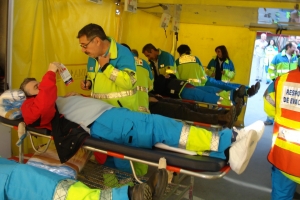Catastrophe Management (an article from: El Adelantado de Segovia)
01/12/2009
TASSICA, a Segovian enterprise, introduces Triage Card in order to improve the operations of emergency services.
In sanitary terms, Incidents with Multiple Victims (IMV) are considered an accident with a number of injured persons that goes beyond the capacities of medical ambulances and their teams made available for the care at the site of the victims. In order to imagine the dimensions, in Madrid an IMV is considered an accident with 25 victims, whereas in Segovia it would already be a number of 10 victims that qualifies as an IMV.
In cases like this the problems concatenate. Some of the pending duties are carrying out adequate triages that prioritize the sanitary care according to the necessities of the patients and centralizing and structuring appropriate information that for example permits the advancement of decision-making and facilitates the traceability of the affected persons.
The Segovian Alberto Montarelo, family doctor, specialized in emergencies, is an expert in such cases. Together with his associate Carlos Sierra he created a business. TASSICA, which supports a revolutionary professional Triage Card that unites the advantages of a thorough questionnaire and the unification of the protocols of action and the transfer of the information across the whole process chain from the first triage to the arrival at the hospital. Imagine an accident with dozens of injured people.
The first thing to do in sich a case is an analysis of the situation of the injured and the mobility of the resources. In the middle of the chaos, the psychological impact of the tragedy and the impossible logistic situation, the number problems rises dramatically. “In order to indicate a certain aspect, the personnel has to transfer information in a quick and precise way about how many injured people there are and in which condition they are to mobilize the necessary recourses.”, explains Montarelo. If this information is gathered from the different operating participants, the chaos is cleared up.
The card resolves this issue in an easy and systematic way without giving rise to further complications in the process of fulfilling the collection of personal data. Through establishing the following it is a second triage of evacuation. An injured person marked red has the maximum urgency of evacuation and together with the victim travels a part of the card with the data of treatment effected, while the other part stays with the team in order to be able to collect and centralize the information.
“This way we manage to unify the protocols, it is not precisely a highly specialized formation, the information flows adequately and the allocation of the available resources is optimized simultaneously, the traceability of the victim is guaranteed, each member knows who was evacuated to which center and the time of reaction is reduced substantially.”, explains Montarelo, who was working right in the middle of catastrophes like the flight 5022 of Spanair or the attack of March 11th.The system is currently introduced in the SUMA in Madrid and the objective is for it to be established as a standard in all the emergency services.
“Our business model is not to sell the card”, explains Sierra, “but to impart the inherent formation about its application. In fact, in the medium term, it is our goal to consolidate a center of formation specialized in these emergencies in Segovia.”




 2016_988e4d.jpg)

